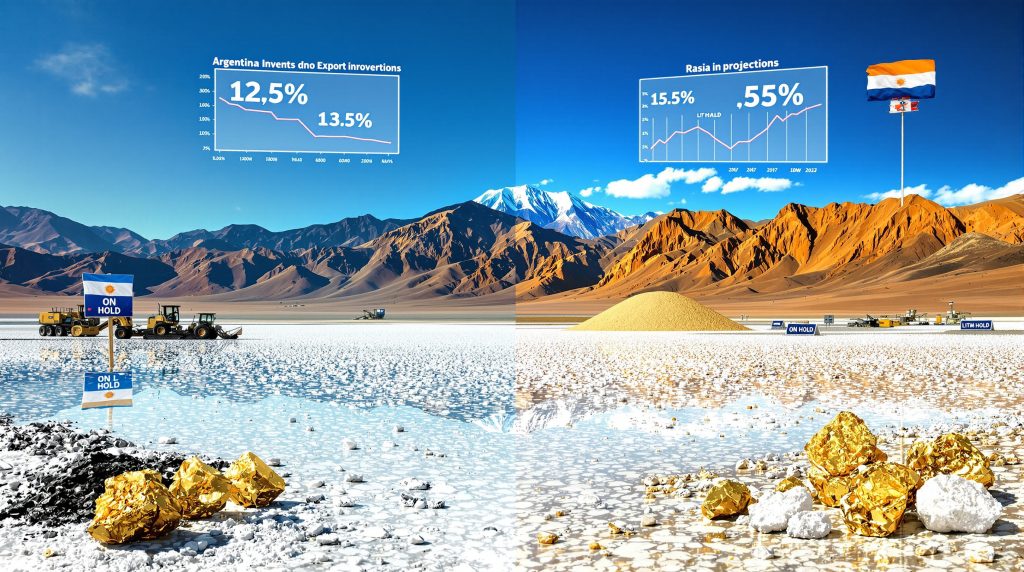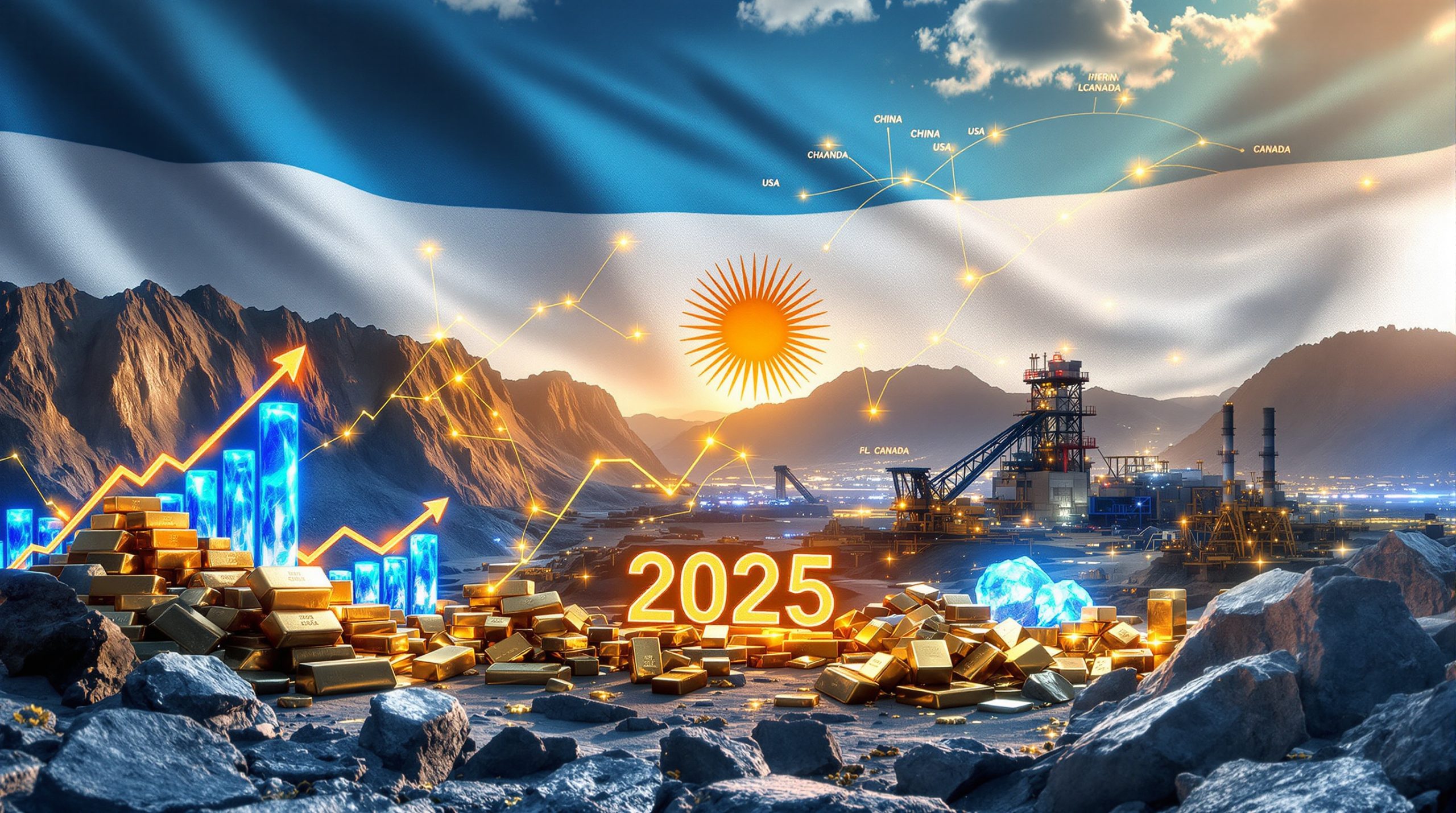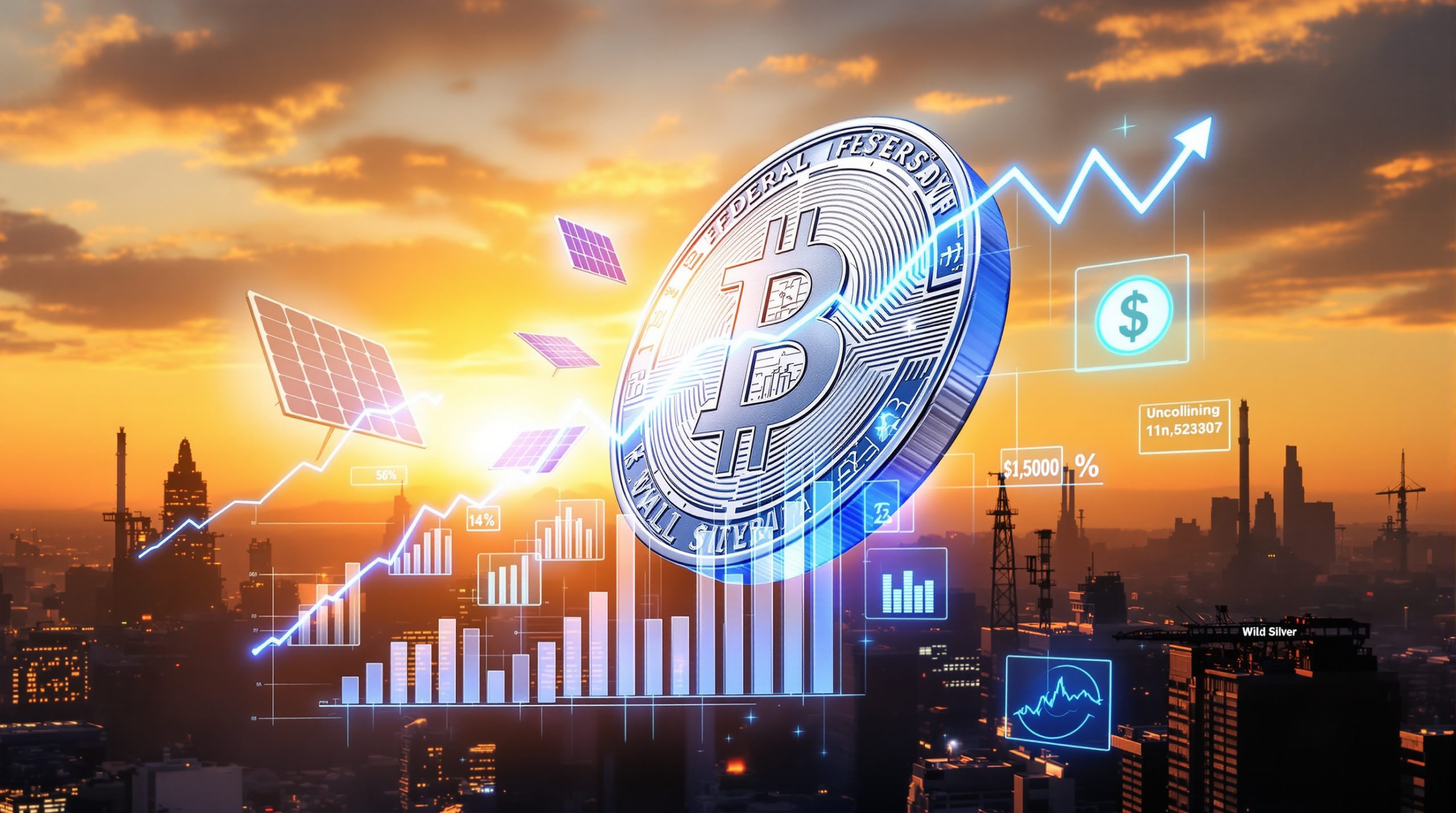Argentina's Mining Sector: Political Uncertainty Freezes Investment Decisions
Argentina's mining sector faces a critical standstill as political uncertainty surrounding the upcoming October 26, 2025 midterm elections has effectively frozen new argentina mining investment on pause. Industry leaders report that unclear policy signals and governance challenges have created a climate where investors are unwilling to commit to new projects until the political landscape clarifies.
The electoral checkpoint represents a crucial test for President Javier Milei's administration, which currently faces declining approval ratings and the challenge of navigating legislation through an opposition-controlled Congress.
Political Landscape Creating Investment Paralysis
Roberto Cacciola, president of the Argentine Chamber of Mining Companies (CAEM), has been explicit about the current situation: "No one is going to make any decisions these days. That's crystal clear." This investment paralysis stems from multiple factors affecting the mining sector's confidence:
- Strained relations between national government and provincial authorities
- Uncertainty about post-election mining policies
- Concerns regarding regulatory stability
- Questions about the administration's ability to implement pro-mining reforms
Industry observers note that this hesitation comes at a particularly challenging time, as the country seeks to capitalize on its abundant mineral resources amid volatile global markets.
Provincial-Federal Tension: A Critical Governance Challenge
Under Argentina's 1994 Constitution (Article 124), provinces maintain control over mineral resources, creating a complex governance structure that requires collaboration between multiple levels of government. The current breakdown in dialogue between federal authorities and provincial governors has created significant barriers to investment certainty.
This constitutional framework means mining companies must navigate relationships with both national and provincial governments, complicating development plans when these entities are not aligned on policy priorities.
What's at Stake for Argentina's Mining Sector?
Argentina's mining industry stands at a crossroads, with record export potential contrasting sharply with production challenges in certain minerals. The sector's performance reveals a complex picture of both opportunity and constraint.
Record Export Potential Amid Production Challenges
Despite the political headwinds, Argentina's mining sector shows remarkable potential according to CAEM projections:
| Metric | 2025 Projection | Year-Over-Year Change |
|---|---|---|
| Total Mining Exports | $5.09 billion | +14% from 2024 |
| Gold Production | Not specified | -10% (down 39% from 2018) |
| Lithium Production | Not specified | +54% |
| Lithium Exports | Not specified | +43% |
This contradictory picture—rising export values despite production challenges in gold—highlights the complex dynamics affecting different minerals within the sector.
Commodity Breakdown of Mining Exports
Argentina's mining export portfolio remains heavily concentrated among three primary commodities:
- Gold: 80% of total mining exports
- Lithium: 14% of total mining exports
- Silver: 12% of total mining exports
This concentration creates both opportunity and vulnerability, as fluctuations in any one commodity—particularly gold prices analysis—can significantly impact overall export performance.
Lithium Sector: Growth Potential Amid Market Challenges
The lithium sector presents a particularly interesting case of opportunity mixed with challenges:
- Production is projected to increase by 54% in 2025
- Export values are expected to rise 43%
- Global oversupply has depressed prices
- Rising domestic costs have slowed project development
- Early signs of corporate restructuring are appearing, though major layoffs haven't materialized
This mixed picture reflects the intersection of Argentina's substantial Argentina lithium insights with challenging global market conditions and domestic operational hurdles.
How Is the Global Market Affecting Argentina's Mining Prospects?
Global market dynamics play a crucial role in shaping Argentina's mining sector outlook, creating both opportunities and headwinds for different mineral segments.
Lithium Market Dynamics
The global lithium market is experiencing significant volatility that directly impacts Argentina's development plans:
- Oversupply conditions have pushed prices downward from historic highs
- Demand growth has slowed from previous projections
- Several planned lithium projects face delays due to unfavorable economics
- Companies are reassessing expansion timelines and investment priorities
This market volatility follows a period of extraordinary price spikes in 2022-2023, when lithium carbonate prices exceeded $80,000 per tonne before retreating substantially. For Argentina's developing lithium sector, these fluctuations complicate investment decisions and project timelines.
Gold Production Decline
The projected 10% year-on-year decline in gold output represents a concerning trend, especially considering production is already down 39% from 2018 levels. This decline occurs despite gold representing 80% of Argentina's mining exports, highlighting structural challenges in sustaining production levels.
The production decline affects operations across key mining provinces, including Santa Cruz and San Juan, where major gold operations like Cerro Negro (Newmont) and Veladero (Barrick Gold) have faced challenges ranging from resource depletion to operational constraints.
What Reforms Are Industry Leaders Requesting?
Industry representatives have outlined specific policy changes they believe are necessary to restore confidence and stimulate investment in Argentina's mining sector.
Policy Recommendations from CAEM
The mining industry, through CAEM, has outlined several specific policy changes needed to restore investor confidence:
- Elimination of export duties on gold, lithium, and silver
- Removal of withholding taxes on gold and silver
- Clarification of glacier protection legislation to reduce regulatory uncertainty
- Infrastructure investment to improve sector competitiveness
- Restoration of dialogue between national and provincial authorities
These recommendations target both fiscal burdens that reduce investment returns and regulatory uncertainties that complicate project planning.
Regulatory Clarity on Environmental Protection
The ambiguity surrounding Argentina's National Glacier Law (Law 26,639, enacted in 2010) has created significant uncertainty for mining projects in mountainous regions. Industry leaders are calling for clearer guidelines that balance environmental protection with resource development opportunities.
The law protects glaciers and periglacial environments, but technical definitions of protected areas and the scope of restricted activities remain contentious, creating investment barriers for high-altitude mining projects in Argentina's Andean regions.
What Investment Incentives Exist Despite the Challenges?
Despite current hesitations, Argentina has implemented frameworks to attract mining investment and maintains significant geological potential that continues to draw interest.
The RIGI Framework
Argentina has implemented the Large Investment Incentive Regime (RIGI), which offers significant benefits for projects exceeding $200 million:
- Tax stability provisions
- Customs duty protections
- Currency exchange guarantees
- Streamlined permitting processes
This framework has attracted interest from major mining companies, though implementation questions remain amid the current political uncertainty. The minimum $200 million investment threshold targets large-scale projects that can significantly impact Argentina's export profile.
Resource Potential as a Long-Term Driver
Argentina's substantial mineral endowment continues to attract strategic interest despite short-term challenges:
- Significant undeveloped copper reserves in projects like El Pachón and Los Azules
- World-class lithium resources in the "Lithium Triangle" (shared with Chile and Bolivia)
- Established gold and silver production history in provinces like Santa Cruz and San Juan
- Diversified mineral portfolio offering investment options across multiple commodities
The "Lithium Triangle" represents a particularly valuable asset, containing approximately 58% of global lithium brine resources across portions of northwest Argentina, southwest Bolivia, and northern Chile.
How Might the Elections Impact Mining Policy?
The upcoming midterm elections represent a pivotal moment that could significantly reshape Argentina's mining policy landscape and investment climate.
Potential Post-Election Scenarios
The outcome of the midterm elections could significantly reshape Argentina's mining policy landscape in several ways:
- A strengthened mandate for Milei could accelerate pro-investment reforms
- Opposition gains might further complicate the legislative path for mining reforms
- Provincial election results could shift the balance of power in resource-rich regions
- Coalition-building requirements might necessitate compromise on mining policies
These elections will determine the composition of half the Chamber of Deputies and one-third of the Senate, potentially altering the legislative dynamics that Milei has faced during his first two years in office.
Governance Challenges Beyond the Elections
Regardless of electoral outcomes, several structural governance challenges will continue to affect mining investment:
- Federal-provincial coordination mechanisms
- Regulatory consistency across jurisdictions
- Infrastructure development responsibilities
- Revenue sharing arrangements
- Environmental protection standards
These governance challenges reflect Argentina's constitutional framework and will require attention regardless of which political forces emerge stronger from the elections.
What Are the Infrastructure Bottlenecks Limiting Mining Development?
Infrastructure limitations represent a significant constraint on Argentina's mining potential, affecting project economics and development timelines across the sector.
Critical Infrastructure Gaps
Argentina's mining sector faces significant infrastructure constraints that limit its competitiveness:
- Limited transportation networks in remote mining regions
- Insufficient power generation and transmission capacity
- Water management challenges in arid mining areas
- Telecommunications limitations in remote operations
- Port facilities requiring modernization for efficient export
These constraints are particularly acute for projects in northwestern provinces like Jujuy, Salta, and Catamarca, where lithium operations face high-altitude conditions (often above 3,000-4,000 meters) and extreme distances from export facilities.
Public-Private Partnership Opportunities
The infrastructure gap presents potential for innovative public-private partnerships to address critical needs:
- Joint development of transportation corridors
- Shared power generation facilities
- Collaborative water management systems
- Coordinated telecommunications investments
- Modernized port facilities with multi-user access
Cross-border infrastructure collaboration, particularly with Chile, represents an important opportunity, as many Argentine mining operations rely on Chilean ports for export access via routes like the Paso de San Francisco international crossing.
FAQ: Argentina's Mining Investment Climate
How does Argentina's mining potential compare to neighboring countries?
Argentina possesses world-class mineral resources comparable to Chile and Peru but has developed them less extensively. The country has particularly significant lithium resources as part of the "Lithium Triangle" shared with Bolivia and Chile, substantial undeveloped copper reserves, and established gold and silver production. However, Argentina has attracted less investment than Chile due to political instability, economic volatility, and regulatory uncertainty.
The Fraser Institute's Policy Perception Index consistently ranks Argentina lower than Chile and Peru on policy attractiveness for mining investment, highlighting the impact of governance factors on resource development.
What economic factors beyond politics are affecting mining investment?
Beyond political uncertainty, investors must navigate Argentina's challenging macroeconomic environment, including inflation exceeding 200%, currency instability, capital controls restricting profit repatriation, high interest rates, and rising operational costs. These factors significantly complicate investment decisions and financial modeling for long-term projects.
The current economic context makes Argentina particularly challenging for capital-intensive mining projects with long development timelines, as companies struggle to forecast costs and returns in a highly volatile environment.
How do provincial mining regulations differ across Argentina?
Argentina's federal system grants provinces control over natural resources, creating significant regulatory variations. Some provinces like San Juan and Santa Cruz have developed robust mining frameworks and attracted substantial investment, while others like Chubut have implemented restrictions or outright bans on certain mining activities. This patchwork creates additional complexity for investors evaluating opportunities across different regions.
Provincial differences include:
- San Juan: Established mining code, significant investment in projects like Veladero
- Santa Cruz: Active mining sector with multiple operating mines
- Catamarca: Home to historical operations and developing lithium projects
- Chubut: Provincial law banning open-pit mining and use of cyanide since 2003
- Mendoza: Law 7722 (2007) restricting mining activities, subject to ongoing debate
What is the timeline for major mining projects currently under development?
Despite current uncertainties, several significant projects continue advancing, though often at adjusted paces. Major lithium projects typically require 3-5 years from investment decision to production, while large copper developments may need 5-8 years. Several projects that secured approval under the RIGI framework before the current political uncertainty continue progressing toward development milestones.
Key projects to watch include lithium operations like Sal de Vida (Arcadium Lithium), Caucharí-Olaroz (Ganfeng/Lithium Americas), and copper prospects like El Pachón and Los Azules, which represent potential major additions to Argentina's mining portfolio.
Balancing Potential Against Political Reality
Argentina's mining sector stands at a critical juncture where extraordinary mineral exploration importance confronts challenging political and economic realities. The upcoming midterm elections represent a pivotal moment that could either unlock investment through policy clarity and governance stability or prolong uncertainty that keeps billions in potential argentina mining investment on pause.
For investors, the current pause provides an opportunity to reassess strategies, engage with stakeholders across the political spectrum, and position for potential post-election scenarios. While immediate investment decisions remain frozen, the fundamental resource potential continues to attract strategic interest from companies with long-term perspectives.
The mining industry's recommendations for policy reforms—from tax structure changes to regulatory clarity—provide a roadmap for addressing key investor concerns. However, implementation depends on political will and governance capacity that remain uncertain until after the electoral results are known and new power dynamics emerge.
Argentina's mining potential remains extraordinary, but unlocking it requires addressing the political, economic, and infrastructure challenges that currently keep investment decisions on pause. Furthermore, ongoing industry consolidation trends and global economic factors including the recent silver market squeeze will continue to shape the investment landscape for Argentina's resource sector.
Further Exploration:
Readers interested in learning more about Argentina's mining sector can also explore related educational content from MINING.com, which offers ongoing coverage of mining developments across Latin America.
Looking for Early Alerts on Major Mineral Discoveries?
Stay ahead of the market with Discovery Alert's proprietary Discovery IQ model, which provides real-time notifications of significant ASX mineral discoveries before they make headlines. Explore historic returns of major mineral discoveries and position yourself for potentially transformative investment opportunities at https://discoveryalert.com.au/discoveries/.




